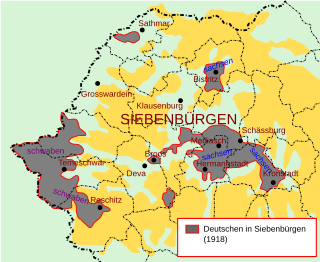
Back Seofonbyrigseaxisc sprǣc ANG Трансилвански саксонски език Bulgarian Siebenbürgisch-Sächsisch German Sajón de Transilvania Spanish Transilvaania saksi murre Estonian Dialecte saxon de Transylvanie French Siebenbürgisk-Seksisk FRR Erdélyi szász nyelv Hungarian Dialetto sassone di Transilvania Italian Zevenburger Saksisch Dutch
| Transylvanian Saxon | |
|---|---|
| Siweberjesch-Såksesch/Såksesch | |
 | |
| Native to | |
| Region | |
Native speakers | 200,000[1] |
| Language codes | |
| ISO 639-3 | – |
| Glottolog | tran1294 |
 Areas where Transylvanian Saxon was spoken in the Kingdom of Romania in 1918 (the grey-coloured areas to the west denote where Swabian was spoken). | |
 Transylvanian Saxon is classified as Severely Endangered by the UNESCO Atlas of the World's Languages in Danger | |
Transylvanian Saxon is the native German dialect of the Transylvanian Saxons, an ethnic German minority group from Transylvania in central Romania, and is also one of the three oldest ethnic German and German-speaking groups of the German diaspora in Central and Eastern Europe, along with the Baltic Germans and Zipser Germans.[2][3] In addition, the Transylvanian Saxons are the eldest ethnic German group of all constituent others forming the broader community of the Germans of Romania.
The dialect is known by the endonym Siweberjesch Såksesch or just Såksesch; in German as Siebenbürgisch-Sächsisch, Siebenbürgisch-sächsischer Dialekt/Mundart, or Die siebenbürgisch-sächsische Sprache (obsolete German spelling: Siebenbürgisch Teutsch); in Transylvanian Landler dialect as Soksisch; in Hungarian as erdélyi szász nyelv; and in Romanian as Limba săsească, săsește, or dialectul săsesc.
Linguistically, the Transylvanian Saxon dialect is very close to Luxembourgish (especially regarding its vocabulary). This is because many ancestors of the present-day Transylvanian Saxons stemmed from contemporary Luxembourg as early as the 12th century, especially in the area of contemporary Sibiu County (German: Kreis Hermannstadt), as part of the Ostsiedlung process. In their case, the Ostsiedlung colonisation process took place in southern, southeastern, and northeastern Transylvania for economic development, guarding the easternmost borders of the former Kingdom of Hungary as well as mining, especially in the area of Bistrița (German: Bistritz or Nösen, archaic form).[4]
Consequently, the Transylvanian Saxon dialect has been spoken in the south, southeast, and northeast of Transylvania since the High Middle Ages onwards.[5][6] In addition, the Transylvanian Saxon dialect is also similar to the Zipser German dialect spoken by the Zipsers in Spiš (German: Zips), northeastern Slovakia as well as Maramureș (i.e. Maramureș County) and Bukovina (i.e. Suceava County), northeastern Romania.[7]
There are two main types or varieties of the dialect, more specifically northern Transylvanian Saxon (German: Nordsiebenbürgisch), spoken in Nösnerland (Romanian: Țara Năsăudului) including the dialect of Bistrița, and south Transylvanian Saxon (German: Südsiebenbürgisch), including, most notably, the dialect of Sibiu (German: Hermannstadt). In the process of its development, the Transylvanian Saxon dialect has been influenced by Romanian and Hungarian as well.[8] Nowadays, given its relatively small number of native speakers worldwide, the dialect is severely endangered.
Cite error: There are <ref group=lower-alpha> tags or {{efn}} templates on this page, but the references will not show without a {{reflist|group=lower-alpha}} template or {{notelist}} template (see the help page).
- ^ "Transylvanian Saxon (Siweberjesch Såksesch)". Omniglot. Retrieved 18 September 2022.
- ^ Victor Rouă (19 August 2015). "A Brief History Of The Transylvanian Saxon Dialect". The Dockyards. Retrieved 18 September 2022.
- ^ Adelheid Frățilă, Hildegard-Anna Falk (January 2011). "Das siebenbürgisch-sächsische eine inselmundart im vergleich mit dem Hochdeutschen" (PDF). Neue Didaktik (in German). Retrieved 5 December 2022.
- ^ Vu(m) Nathalie Lodhi (13 January 2020). "The Transylvanian Saxon dialect, a not-so-distant cousin of Luxembourgish". RTL Luxembourg. Retrieved 2 February 2023.
- ^ Ariana Bancu (March 2020). "Transylvanian Saxon dialectal areas". RsearchGate. Retrieved 21 February 2023.
- ^ Ariana Bancu. "The Transylvanian Saxon language islands around 1913 (Source: Klein 1961, map number 3)" (in German). Research Gate. Retrieved 22 February 2023.
- ^ Helmut Protze (2006). "Die Zipser Sachsen im sprachgeographischen und sprachhistorischen Vergleich zu den Siebenbürger Sachsen". Central and Eastern European Online Library (in German). Arbeitskreis für Siebenbürgische Landeskunde. Retrieved 14 April 2023.
- ^ Sigrid Haldenwang. "Zur Entlehnung rumänischer Verben ins Siebenbürgisch-Sächsische aufgrund von Fallbeispielen" (PDF). Academic article (in German). Retrieved 26 February 2023.
© MMXXIII Rich X Search. We shall prevail. All rights reserved. Rich X Search